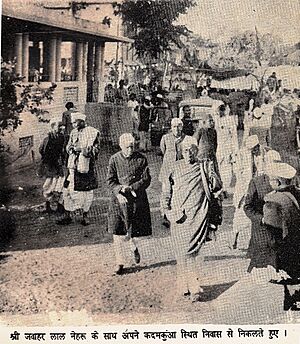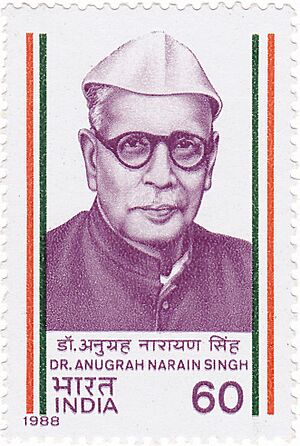Anugrah Narayan Sinha facts for kids
Quick facts for kids
Anugrah Narayan Singh
|
|
|---|---|
 |
|
| 1st Deputy Chief Minister of Bihar and Finance Minister of Bihar | |
| In office 2 April 1946 – 5 July 1957 |
|
| Chief Minister | Sri Krishna Sinha |
| Preceded by | Position Created |
| Succeeded by | Vacant |
| Member Of Constituent Assembly | |
| In office 9 December 1946 – 26 January 1950 |
|
| Preceded by | Post Created |
| Succeeded by | Post Abolished |
| Constituency | Aurangabad |
| Deputy Premier and Finance Minister of Bihar Province | |
| In office 20 July 1937 – 31 October 1939 |
|
| Preceded by | Position established |
| Succeeded by | Governor's rule |
| Member Central Legislative Council | |
| In office 1926–1930 |
|
| Governor General | The Earl of Halifax |
| Preceded by | Maharaja Rameshwar Singh |
| Succeeded by | Vacant |
| Member Central Legislative Assembly | |
| In office 1923–1926 |
|
| Governor General | The Earl of Reading |
| Preceded by | Ambika Prasad Sinha |
| Succeeded by | Badri Lal Rastogi |
| Personal details | |
| Born | 18 June 1887 Poiwan, Bengal Presidency, British India (present-day Bihar, India) |
| Died | 5 July 1957 (aged 70) Patna, Bihar, India |
| Political party | Indian National Congress |
| Children | 2 |
| Alma mater |
|
| Occupation | Lawyer Nationalist Statesman Educationist Administrator |
| Nickname | Bihar Vibhuti |
| MERAY SANSMARAN | |
|
As of 12 July, 2006
Source: [1] |
|
Anugrah Narayan Sinha (born June 18, 1887 – died July 5, 1957) was a very important leader in India's fight for freedom. People often called him Bihar Vibhuti, which means "Jewel of Bihar." He helped build modern Bihar and was the first Deputy Chief Minister and Finance Minister of the state from 1946 to 1957.
Anugrah Narayan Sinha, also known as Anugrah Babu, worked closely with Mahatma Gandhi during the freedom movement. He also teamed up with Bihar Kesari Sri Krishna Sinha to lead Gandhi's peaceful protest movement in Bihar. He was a key nationalist leader from Bihar, second only to Dr. Rajendra Prasad. He played a big role in writing the Constitution of India as a member of the Constituent Assembly of India.
Contents
Early Life and Education
Anugrah Narayan Sinha was born on June 18, 1887, in Poiwan village, which is now part of the Aurangabad district in Bihar. Even as a young boy, he showed strong patriotic feelings. He was a brilliant student and always did well in his studies.
He earned his Master's degree in History in 1914 from the famous University of Calcutta. He became the Secretary of the Bihar Students Conference, which was started by Rajendra Prasad. He also helped organize the Patna Congress, even when he had a fever. In 1915, he became a History Professor at T.N.B. College in Bhagalpur. He was known as an excellent teacher. He also helped people when Bhagalpur was hit by floods. Later, he started a successful law practice at Patna High Court.
Fighting for Freedom

In 1917, Anugrah Narayan Sinha stopped his law practice to join Mahatma Gandhi's Champaran Satyagraha movement. This was a peaceful protest against unfair farming rules. His involvement in this movement made him famous across India.
He taught at Bihar Vidyapeeth, a school founded by Rajendra Prasad to inspire young people. One of his first students was Jayaprakash Narayan. In 1922, he helped organize the Gaya Congress meeting. The next year, he became a General Secretary of the All India Congress Committee. He also served as Vice-Chairman of the Patna Municipality.
Anugrah Narayan Sinha was a main leader in the Civil Disobedience Movement led by Mahatma Gandhi in 1930. This movement was a very important step in India's journey to independence. Because of his patriotism, he was put in prison for 15 months in 1933–34.
When a big earthquake hit Nepal and Bihar in 1934, he became the Vice-President of the Bihar Central Relief Committee. He worked hard to raise money and organize help for the affected people. In 1936, he became a member of the Bihar Legislative Assembly.
In 1937, when Bihar got its first Congress government, he became the Deputy Premier and Finance Minister. He and Premier Sri Krishna Sinha even resigned once because they disagreed with the British Governor about releasing political prisoners. The Governor eventually agreed, and they returned to their positions. However, they resigned again in 1939, along with other Congress governments, because India was involved in World War II without its people's consent.
He was one of the first freedom fighters to join Gandhi's call for Satyagraha (peaceful resistance) in 1940–41. The British arrested him and sent him to Hazaribagh Central Jail in 1942. After his release in 1944, he helped people suffering from epidemics.
After India gained independence, he worked hard for the development of Bihar as its Finance Minister and Deputy Chief Minister of Bihar.
Building Modern Bihar
The first government in Bihar, both in 1937 and 1946, followed the values of Mahatma Gandhi. Its leaders, Shri Krishna Sinha and Anugrah Babu, were honest and dedicated to public service. They ran an excellent government in Bihar.
They started many development projects, including several river valley projects. During India's first five-year plan, they focused on rural development and agriculture. Bihar became the top state in the country for this plan. The then Prime Minister of India Jawaharlal Nehru even sent an expert, Paul H. Appleby, to study state administrations. His report said Bihar was the best-governed state, thanks to the leadership of Shri Krishna Sinha and Anugrah Narayan Sinha.
Later, Anugrah Narayan Sinha led the effort to bring many industries to Bihar, helping the state grow. He also represented India internationally. He led Indian groups to Nepal for food and agriculture discussions and to the International Labour Organization (ILO) meetings in Canada and Switzerland.
Lasting Impact
Anugrah Narayan Sinha is remembered as one of the "architects of modern Bihar," along with Rajendra Prasad and Shri Krishna Sinha. He served as Deputy Chief Minister and Finance Minister from 1937 until his death in 1957, except for the years during World War II.
His younger son, Satyendra Narayan Sinha, also became a famous freedom fighter and later served as the Chief Minister of Bihar. His grandson, Nikhil Kumar, was the Governor of Kerala.
To honor him, the Department of Posts released a special commemorative stamp with his picture. In 2013, Bihar celebrated his 125th birth anniversary with many events. Biographies of both Shri Babu (Sri Krishna Sinha) and Anugrah Babu were added to school textbooks in Bihar.
See Also
- My Autobiography, Or The Story Of My Experiments With Truth (1929) by M.K. Gandhi
- List of politicians from Bihar


